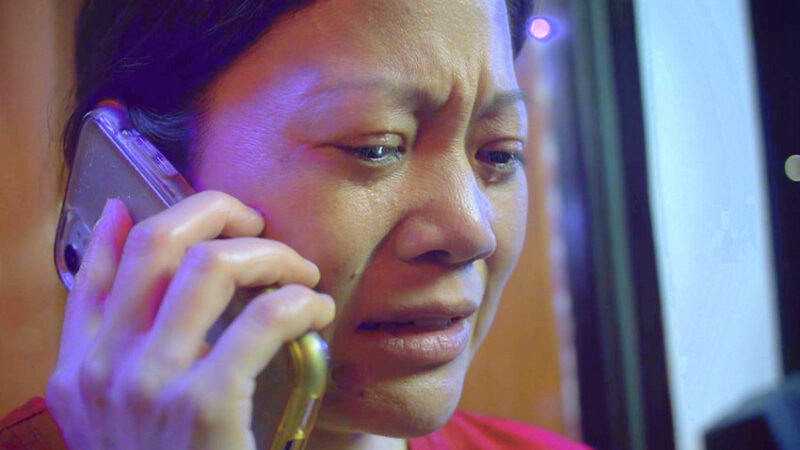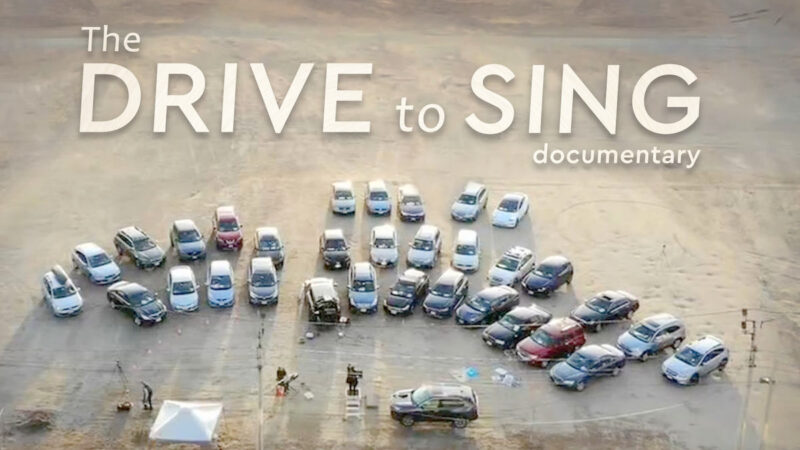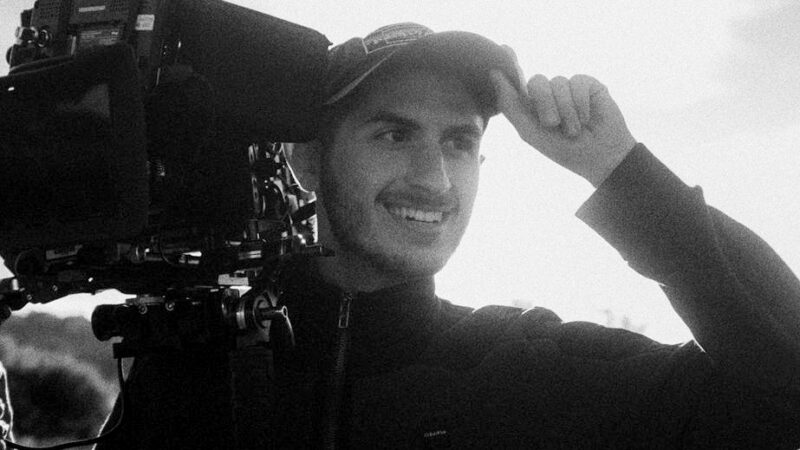
Narrative | Dramatic Features
Film Name: An Introduction to Thribing: Snapshots of Kiren, An Introduction to Thribing (But Just The Parts with Kiren)
Genre: Comedy/Drama
Date: September 2020
Director: Rohil Aniruth
Producer: Rohil Aniruth
Writer: Rohil Aniruth
Cinematographer: Natalie Wolford, Zach Guttman, Kiera Williams, Marlise Chu
Production Company: Thribing Media, Higher Than The Sun
Introduction
Rohil Aniruth (RA): An Introduction to Thribing: Snapshots of Kiren follows the misadventures of South African International student, Kiren, as he tries to get his life together in New York while fighting off the dark influences of an anarchistic manifestation of his dead childhood dog, Mr. Dapper, and a demonic talking backpack.
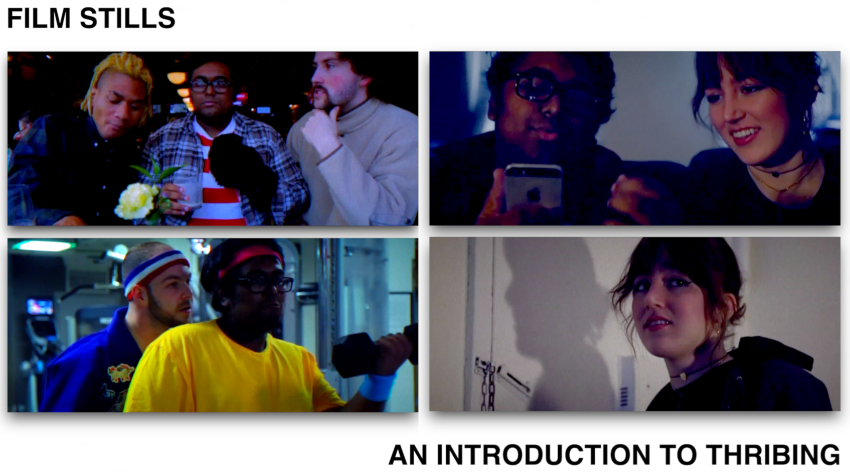
What inspired the initial idea for the film?
Rohil Aniruth (RA): I moved to New York from Cape Town, South Africa, when I was eighteen years old, as an international student. I was studying game design. I wrote and shot this project nearing my graduation when my future in the country was particularly uncertain. This project was an opportunity to get all my friends together (for what could have been the last time) and create something bold and cool. There was a real urgency to it. I got to make a film with the people I love — to see an audience connect with our story is incredible.
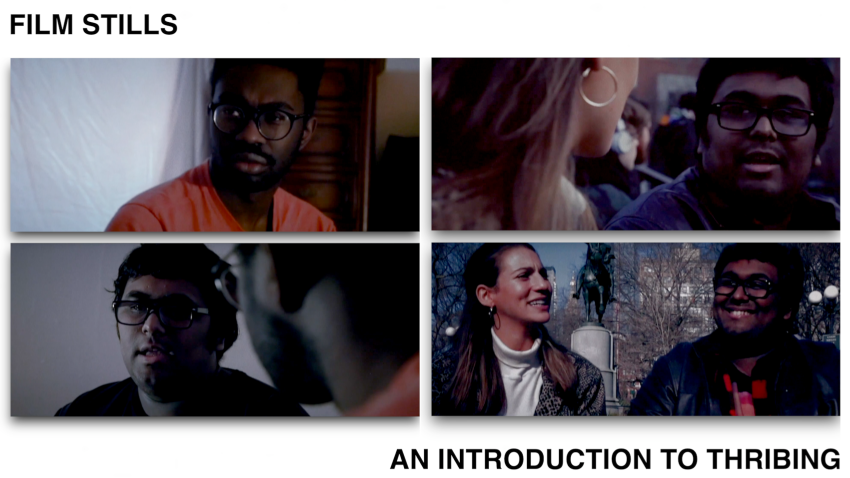
Walk us through the development, financing & production?
Rohil Aniruth (RA): I had specific, formative experiences as an international student. While in the throes of it, I knew I’d process and share some version of those experiences through artistic expression at some point. Most of those became Kiren’s big comedic and dramatic moments of the film. I should point out that while I also portray Kiren in the film, he is not a heightened version of me. I wrote Kiren to have a very different emotional map and body language from myself.
In August 2018, we started with a series of conversations with my international student peers. It was a podcast format — diving into our shared experiences. “What are we feeling as a collective?” That’s what I wanted to tap into. How was each of us dealing with the next phase of transition? These peer stories came together with my own to ground our content.
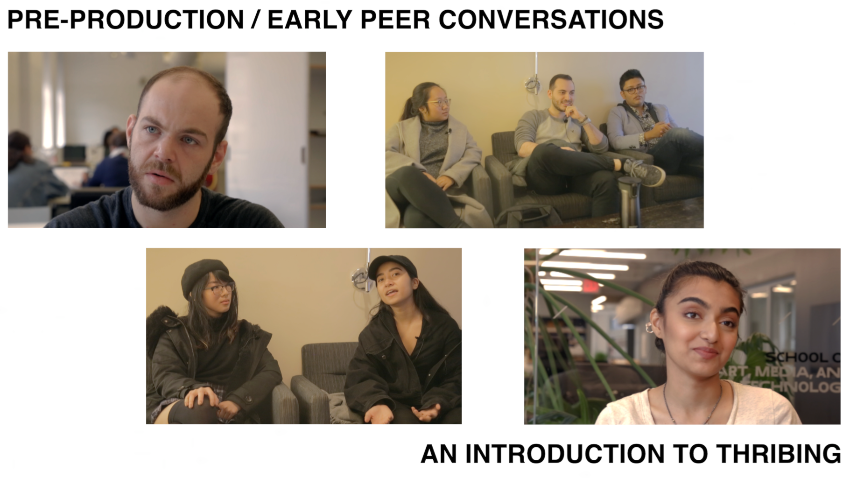
I made a list of intent — some items include:
- I want around a feature-length’s worth of content that can work as short-form and long-form content.
- For the film to break down into smaller snapshots following different characters.
- I want to discuss surveillance, body dysmorphia, and social accountability.
- The vibe should be comedic, vulnerable, and a tad bit cursed.
- To capture contemporary discourse. The dialogue must be true to how we sound, the conversations had among my peer group.
I then spent some time in India trying to find myself, kidding, I spent my days in India partying with the sweetest bros I’ve ever met and eaten delicious food. I came back in 2019 and assembled the team. Some of our cast were professional actors, while others are just charismatic friends who have a commanding on-screen presence. For the latter group, I kept things improvisational, much like our podcast sessions. I had the topics prepped. I knew what I wanted the characters to say, and I knew if we just chatted for a bit, they’d get their thoughts out organically and uninhibited. Intercutting improv with the written stuff gave the film a naturalistic element we needed to balance our demon-backpacks and talking dead doggos.
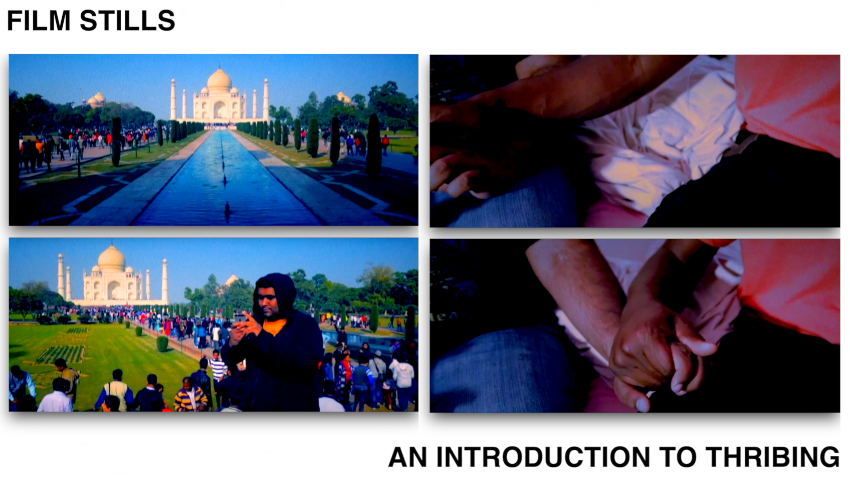
We shot all through 2019. I took on a Narrative Design role at a video game studio in New York, and most of the money earned from that is how the day-to-day production was funded. We shot the film on my 2012 Canon 5D Mark III and a couple Zoom H5 recorders. The challenge was finding a rhythm of working at the game studio, managing our school schedules nearing graduation, figuring out how I’d stay in the country, and making our movie. We started the shoot with one of the bigger comedic moments in the piece — the “Kiren receives the news” scene. It tends to be people’s favorite moment in the film, and the success of that scene is all credited to Natalie Wolford, Paul Michael Wright, and Cooper Hall. Natalie perfectly captured the dark, comedic tone, and Paul & Cooper’s jocular abandon still cracks me up. Principle photography wrapped mid-2019. By the end of the year, we had our festival submission drafts. We finished post-production in 2020 with final cuts in time for festival screening.
How did you achieve the Creature-FX in the film?
Rohil Aniruth (RA): In the film, we have these surreal elements heavily inspired by B-Horror films and horror manga. Through the pre-production conversations, we found that one of the shared experiences among my fellow international students were the not so random “random searches” at airports and security check-points. In America, there is assumed criminality of immigrants — and we feel surveillance paranoia quite intensely. “What if something is in my bag?” For Black and brown people, merely existing in America feels like you’re always carrying something forbidden on you. That feeling was the inspiration behind the “Saikō Bosu” creature, a demonic backpack in the film — achieved through practical creature FX and CGI.
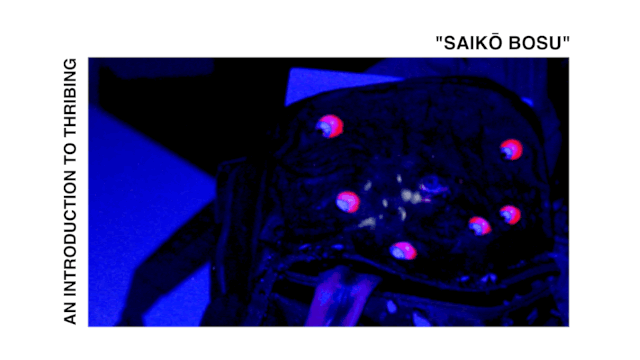
This talking bag from the demon realm latches onto international students and continuously materializes illegal items — the character is an otherworldly manifestation of surveillance paranoia. Saikō Bosu is a puppet we constructed out of an old JanSport bag, thrifted Halloween masks, and a ton of liquid latex. We painted green dots across the bag as reference points of where we’d do the tracking for the CGI eyes later on.
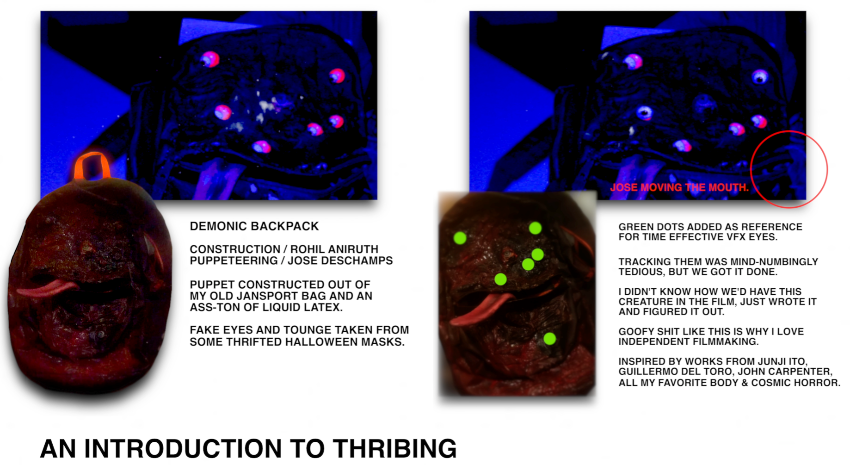
implements an AI safe space that adapts to each individual’s needs. Things turn sinister when the AI receives conflicting information about the student’s personality — and the AI begins to corrupt them. It’s a commentary on privacy, the different ways we present online, and performative allyship from universities who market their wokeness and diversity but ultimately fail their minority students. We chopped these snapshots out of the main film, “An Introduction to Thribing,” and into its own stand-alone short film, “Safety Space.”
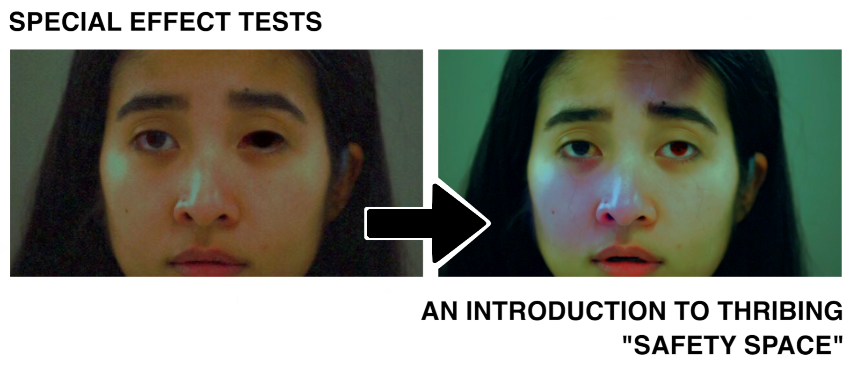
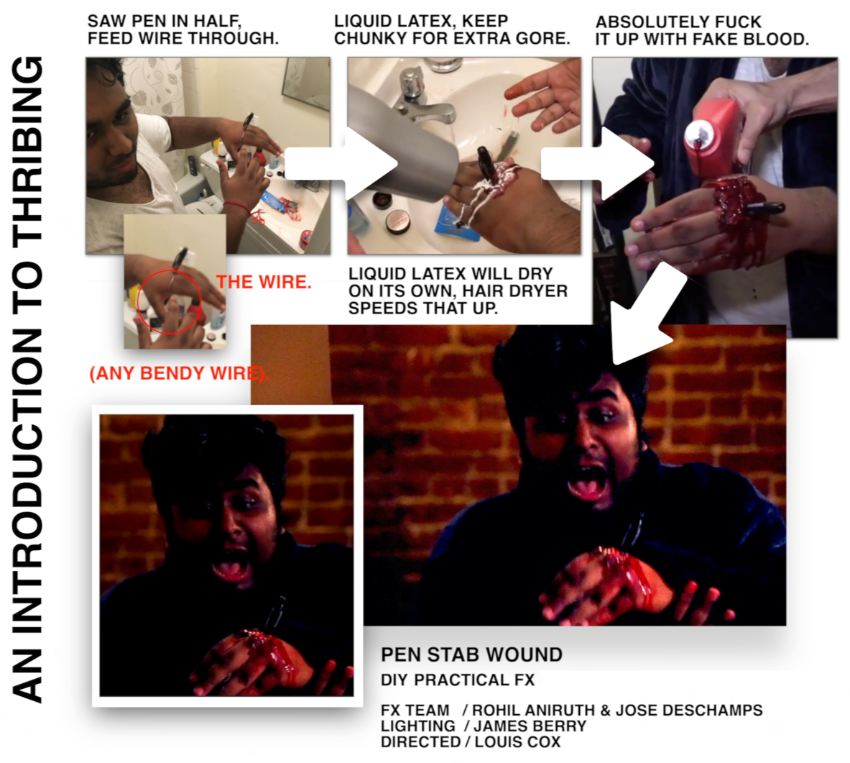
What are some of your other influences?
Rohil Aniruth (RA): Lulu Wang’s The Farewell, Iranian New Wave, Steri Stumpies, Who Killed Captain Alex: Uganda’s First Action Movie (frankly, all of Wakaliwood), that one scene in Kabhi Khushi Kabhi Gham where Shah Rukh Khan is wearing a see-through shirt serenading Kajol by the Pyramids?
Tell us about the festival run, marketing, potential sales, and distribution?
RA: As mentioned, we had a feature-length’s worth of content, and early cuts of the film were feature-length, with more snapshots of other characters surrounding Kiren, each dealing with their own challenges as international students through fantasy or sci-fi elements. Given the modular design of the snapshots, we decided to chop it up into two separate short films, “Safety Space” and “Intrusive Thoughts,” and our main film, “An Introduction to Thribing.” Speaking on the festival run, the shorts won Best Sci-Fi Short at Indie X Festival, Los Angeles, Best Sci-Fi Short at The New York Film Awards, and Best Digital Effects at The International Independent Film Awards.
In 2018, I was a partnered content creator with BroadbandTV & writer for Outspeak. Through that relationship, I received a creator-pass to Stareable Fest to watch some films and check out the panels. I was so inspired by what was happening in the independent digital and television space — I set a goal to showcase my work at the festival. An Introduction to Thribing was selected for the 2020 festival, where we won Best in Editing and Best Long-Form Comedy. I also spoke on the Shutterstock Creative Solutions panel while at the festival and participated in the Long-Form Comedy Q&A. We received great feedback and interest and are moving forward on some development opportunities that have come from the film’s screening at the festival.
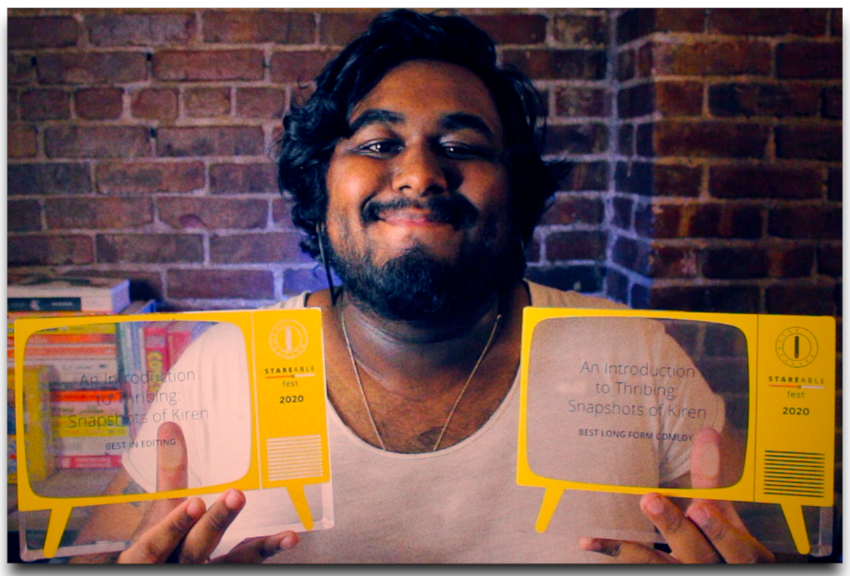
We’re so unapologetically DIY, and the production limitations are not only one of our active aesthetics but also a device we use to drive the characters forward. I think this aesthetic, the circumstances behind our production (potentially being ejected from the country), and the story’s relevance in the current social climate made for an authentic and wholesome package the audience can get behind. I think the fact that we, for the most part, still pulled off some pretty intricate scenes both on the technical side and in the vulnerability of the performances is what excites the industry about our project. We can create something special with limited resources.
A more practical marketing element hard-baked into our production is that the film plays out as a series of snapshots — each ending on comedic or motivational beats and sometimes making use of absurdist editing. These snapshots break down really well as clips for social media — we use baked-in captions as well. This is great for having promotional material ready to go without additional labor, which might be more captivating than traditional trailer roll-outs. We were particular about creating a film that could exist as shorter offbeat videos, like if Vine videos were packaged as douchebag art films. It’s how we chef’d up the original feature-length runtime into short films. I think the modular nature of our movie also encourages remixes and other fun edits. I enjoy videos that take popular movies and series and re-contextualize them, and so I create while affording some room for people to meme the shit out of my work (lovingly). We also made our own “bootleg” DVDs for the film and fake “vintage” merchandise playing into that cult-classic vibe.
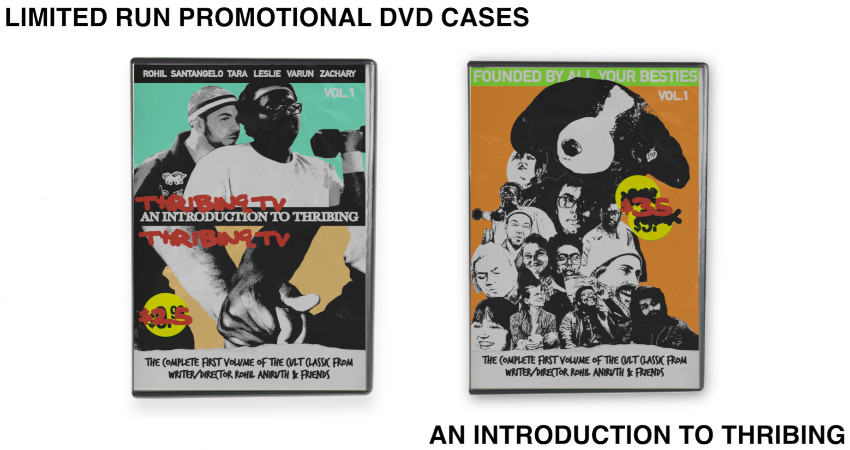
I like this approach to marketing. It’s like when game studios encourage modding and speed-running. Giving people the flexibility with how they want to engage with the art. We encourage an active audience or “fandom” because, ultimately, those people create content around your work — which elevates your cult-status and keeps the work relevant.
Advice from the Filmmaker?
RA: I always say start smart and frugal. Think about what you have access to and a core message you find culturally relevant — something you’re passionate about or have unique experience in. Think about how you can communicate this message with your primary resources. If you’re able to invest money into your project, performance and sound are essential. Good actors can save bad writing, but good writing can’t save bad acting (though you could still end up with a cult hit). Think, how do you make your immediate locations dynamic and cool? If your subject is captivating and the sound is clear, you’re on track to succeed. Definitely, don’t blow a bag on fancy gear; if that’s your go-to impulse, it may be a sign that you lack a strong idea. It’s essential to know how to make cool stuff on a tight budget and learn how to be self-sufficient. Media companies, the people financing, and green lighting projects look for this too.
This second bit of advice I credit to Ra Kumar. A major key is finding the balance between your raw artistic sensibilities and something that can hit the mainstream. Keep refining your voice and finding the best way to communicate your idea. I think a good way to do this is to go back and chart out your favorite creative’s evolution. I used to do this with Donald Glover — from the Derrick Comedy / Mystery Team era to the “Because The Internet” era, leading into Atlanta. How did running themes or ideas in the artist’s work change or refine over time? Pick a creative who has been able to create work that’s authentically themselves while also succeeding in larger mainstream productions. (Issa Rae, Greta Gerwig, Justin Chon, and Nathan Fielder are some other career paths I try to break down this way).
Always try to retain as much ownership of your IP as possible. Your film could be a franchise. If your characters are selling shirts and toys, you should see the revenue from that. Be vigilant about who is eating off your story.
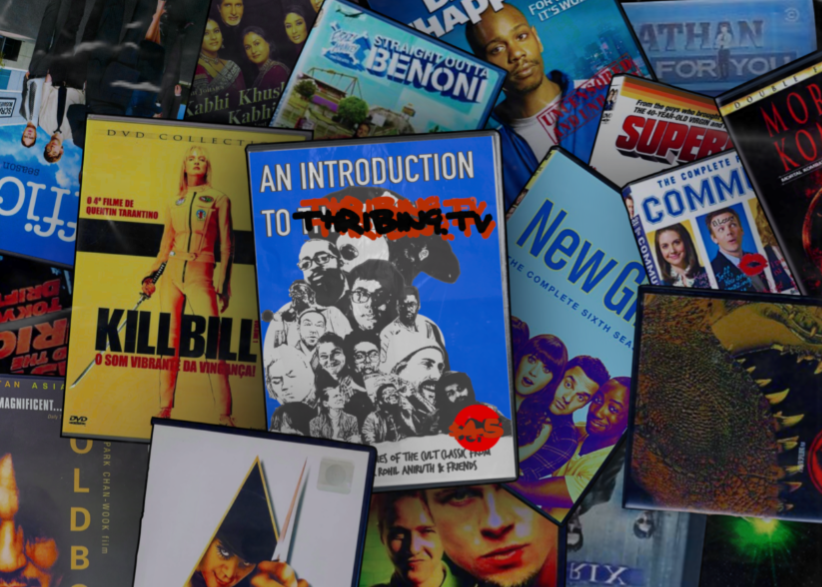
Which other young creatives should watch in this space?
RA: Noah Weisfogel films are spectacular in every sense. The attention to lighting and refined understanding of the relationship between color and emotion is powerful. Eclectic work, too, fearless. Mari Al-Midhadi is a brilliant graphic designer and motion graphics artist. She has a deep, undeniable understanding of culture and what people need from their technology — truly stunning visual work. Godfred Sedano the fluidity of motion in his videos is crazy. Abby Govindan is writing the funniest stuff.
Tell us what you think of An Introduction to Thribing What do you think of it? Genre? More genre? Let’s have your comments below and/or on Facebook or Instagram! Or join me on Twitter
Follow An Introduction to Thribing on Social Media
Website
IMDb
Twitter
Instagram
MORE STORIES FOR YOU

